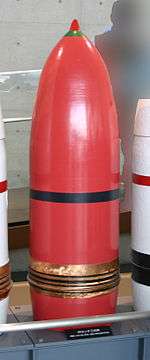San Shiki (anti-aircraft shell)


Sanshikidan (三式弾, "type 3 shell") was a form of ammunition: a World War II-era combined shrapnel and incendiary anti-aircraft round used by the Imperial Japanese Navy. The type of layered construction of the warheads were generically referred to as Beehive rounds.
The Sanshiki anti-aircraft shell was designed for several gun calibers, including the 46 cm (18.1-inch) guns of the Yamato-class battleships.
The 46 cm (18.1 in) Sanshiki Model 13 round weighed 2,998 lb and was filled with 900 incendiary tubes and 600 steel stays. The round was equipped with a delay fuze set before firing that detonated the shell at the set altitude; on explosion, the steel stays and the incendiary tubes were ejected in a 20-degree cone forward, with the shell fragments from the explosion itself further increasing the amount of debris. The incendiary tubes ignited about a half-second later and burned for five seconds with 5 m (16 ft) long flames.[1] Each of the incendiary tubes was a 90 mm long, 25 mm diameter hollow steel cylinder, filled with rubber thermite (phosphorus, vulcanized rubber, natural rubber, stearic acid, sulphur and barium nitrate) and ignited through holes on both sides. The rounds were similar to conventional shells, except for their wood-filled ogive and several layers of assembled fragments.
The blast of the main guns turned out to disrupt the fire of the smaller antiaircraft guns, so the 46 cm rounds were not successful. The copper drive bands of the rounds were poorly machined, and constant firing was damaging the gun rifling.[2]
The 41 cm (16.1 in) round contained 1,200 incendiary tubes and on explosion burst into 2,527 fragments. By contrast a 46 cm round burst into 2,846 fragments. The 20.3 cm (8 in) round weighed 125.86 kg and contained 255 incendiary tubes and a 2 kg burst charge in its base. It used the 91 Shiki delay fuze. Its maximum altitude was 10,000 m. The burst charge scattered the fragments in a 12 degree cone. The maximum effective distance from the shell burst was about 1,000 meters, where the fragments reached dispersion diameter of 100 meters. A 12.7 cm (5 in) round contained 66 incendiary tubes and had a 10 degree dispersion angle with dispersion diameter of 54 meters.
References
- ↑ http://www.battleshipyamato.info/weapons.html
- ↑ Thomas J. Cutler (14 October 2013). The Battle of Leyte Gulf: 23-26 October 1944. Naval Institute Press. pp. 146–. ISBN 978-1-55750-243-8.